Nursing Evidence Based Practice
VerifiedAdded on 2023/02/01
|12
|2895
|56
AI Summary
This paper focuses on evidence based practice guidelines for elderly UTI patients and explores management strategies for UTI and CAUTI. It discusses the importance of preventive measures, such as hand hygiene and catheter assessment, and highlights the need for further research on non-catheter associated UTI management.
Contribute Materials
Your contribution can guide someone’s learning journey. Share your
documents today.
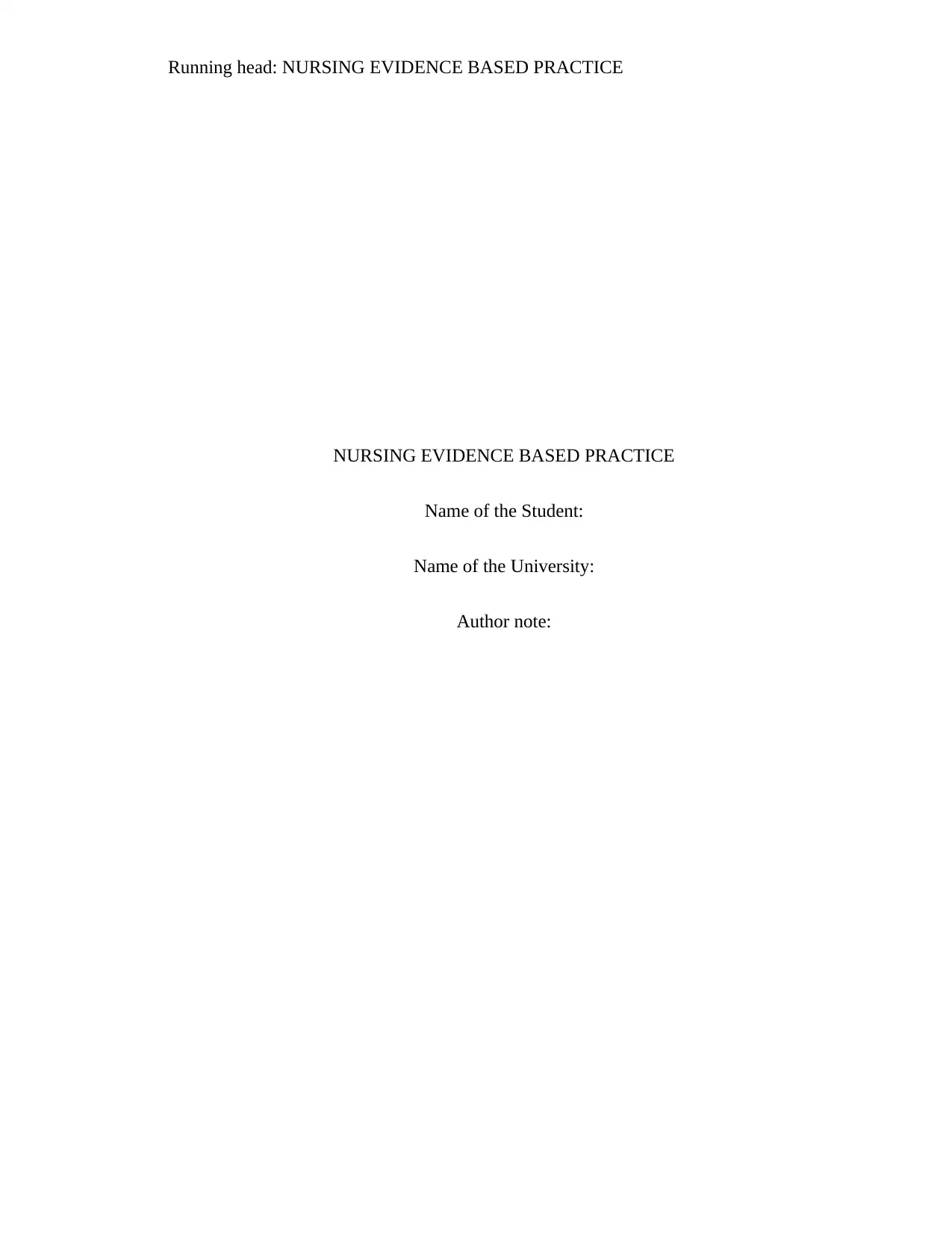
Running head: NURSING EVIDENCE BASED PRACTICE
NURSING EVIDENCE BASED PRACTICE
Name of the Student:
Name of the University:
Author note:
NURSING EVIDENCE BASED PRACTICE
Name of the Student:
Name of the University:
Author note:
Secure Best Marks with AI Grader
Need help grading? Try our AI Grader for instant feedback on your assignments.
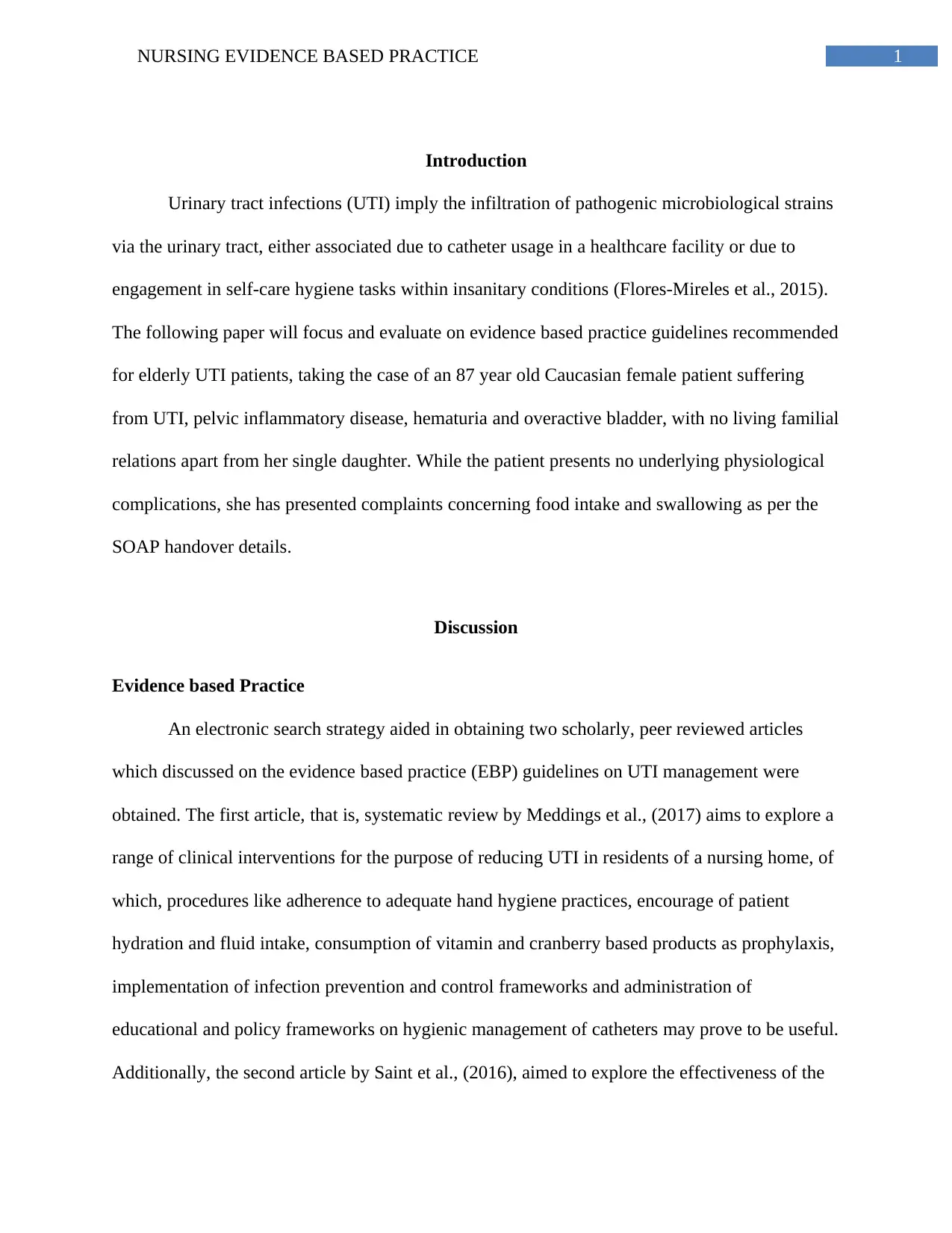
1NURSING EVIDENCE BASED PRACTICE
Introduction
Urinary tract infections (UTI) imply the infiltration of pathogenic microbiological strains
via the urinary tract, either associated due to catheter usage in a healthcare facility or due to
engagement in self-care hygiene tasks within insanitary conditions (Flores-Mireles et al., 2015).
The following paper will focus and evaluate on evidence based practice guidelines recommended
for elderly UTI patients, taking the case of an 87 year old Caucasian female patient suffering
from UTI, pelvic inflammatory disease, hematuria and overactive bladder, with no living familial
relations apart from her single daughter. While the patient presents no underlying physiological
complications, she has presented complaints concerning food intake and swallowing as per the
SOAP handover details.
Discussion
Evidence based Practice
An electronic search strategy aided in obtaining two scholarly, peer reviewed articles
which discussed on the evidence based practice (EBP) guidelines on UTI management were
obtained. The first article, that is, systematic review by Meddings et al., (2017) aims to explore a
range of clinical interventions for the purpose of reducing UTI in residents of a nursing home, of
which, procedures like adherence to adequate hand hygiene practices, encourage of patient
hydration and fluid intake, consumption of vitamin and cranberry based products as prophylaxis,
implementation of infection prevention and control frameworks and administration of
educational and policy frameworks on hygienic management of catheters may prove to be useful.
Additionally, the second article by Saint et al., (2016), aimed to explore the effectiveness of the
Introduction
Urinary tract infections (UTI) imply the infiltration of pathogenic microbiological strains
via the urinary tract, either associated due to catheter usage in a healthcare facility or due to
engagement in self-care hygiene tasks within insanitary conditions (Flores-Mireles et al., 2015).
The following paper will focus and evaluate on evidence based practice guidelines recommended
for elderly UTI patients, taking the case of an 87 year old Caucasian female patient suffering
from UTI, pelvic inflammatory disease, hematuria and overactive bladder, with no living familial
relations apart from her single daughter. While the patient presents no underlying physiological
complications, she has presented complaints concerning food intake and swallowing as per the
SOAP handover details.
Discussion
Evidence based Practice
An electronic search strategy aided in obtaining two scholarly, peer reviewed articles
which discussed on the evidence based practice (EBP) guidelines on UTI management were
obtained. The first article, that is, systematic review by Meddings et al., (2017) aims to explore a
range of clinical interventions for the purpose of reducing UTI in residents of a nursing home, of
which, procedures like adherence to adequate hand hygiene practices, encourage of patient
hydration and fluid intake, consumption of vitamin and cranberry based products as prophylaxis,
implementation of infection prevention and control frameworks and administration of
educational and policy frameworks on hygienic management of catheters may prove to be useful.
Additionally, the second article by Saint et al., (2016), aimed to explore the effectiveness of the
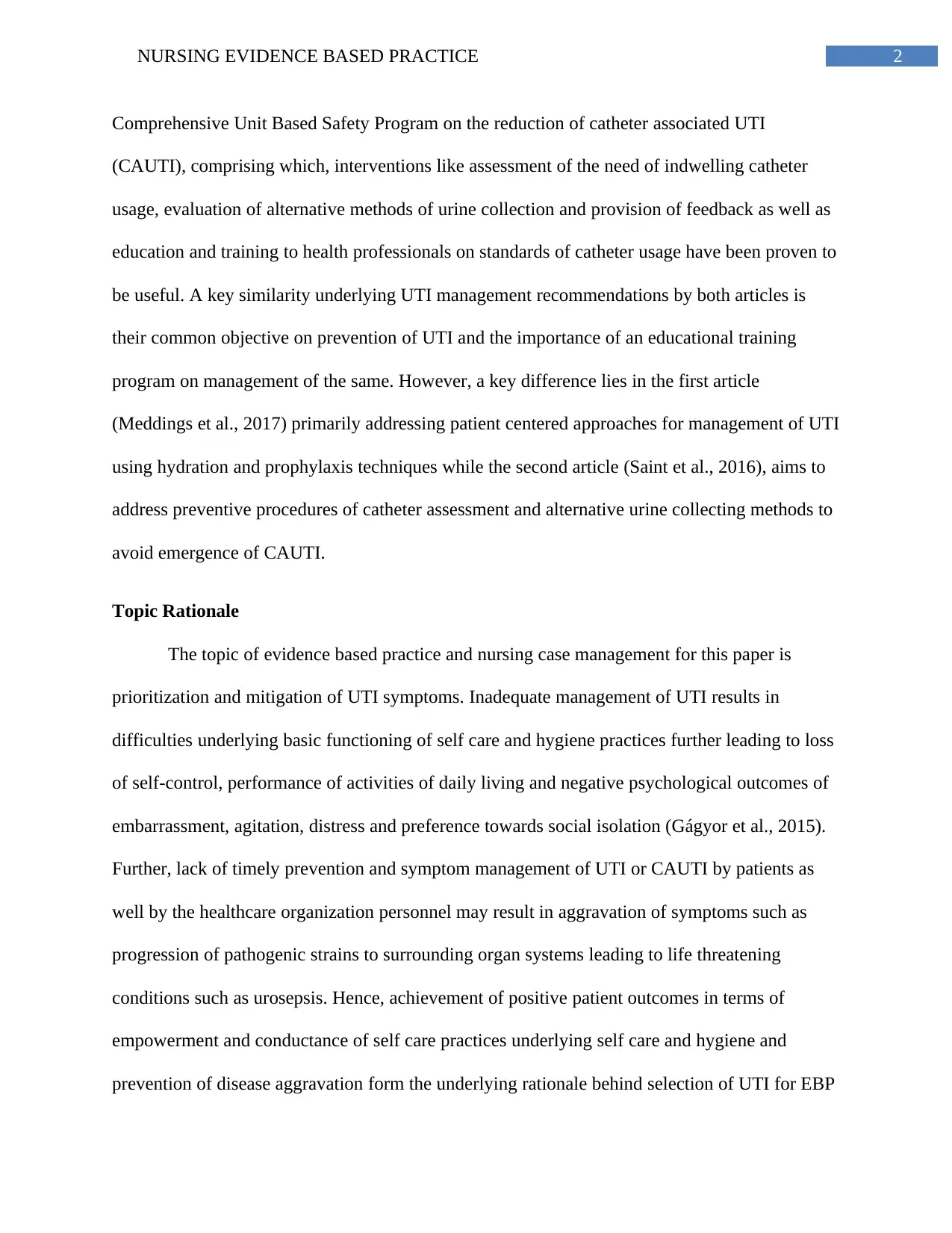
2NURSING EVIDENCE BASED PRACTICE
Comprehensive Unit Based Safety Program on the reduction of catheter associated UTI
(CAUTI), comprising which, interventions like assessment of the need of indwelling catheter
usage, evaluation of alternative methods of urine collection and provision of feedback as well as
education and training to health professionals on standards of catheter usage have been proven to
be useful. A key similarity underlying UTI management recommendations by both articles is
their common objective on prevention of UTI and the importance of an educational training
program on management of the same. However, a key difference lies in the first article
(Meddings et al., 2017) primarily addressing patient centered approaches for management of UTI
using hydration and prophylaxis techniques while the second article (Saint et al., 2016), aims to
address preventive procedures of catheter assessment and alternative urine collecting methods to
avoid emergence of CAUTI.
Topic Rationale
The topic of evidence based practice and nursing case management for this paper is
prioritization and mitigation of UTI symptoms. Inadequate management of UTI results in
difficulties underlying basic functioning of self care and hygiene practices further leading to loss
of self-control, performance of activities of daily living and negative psychological outcomes of
embarrassment, agitation, distress and preference towards social isolation (Gágyor et al., 2015).
Further, lack of timely prevention and symptom management of UTI or CAUTI by patients as
well by the healthcare organization personnel may result in aggravation of symptoms such as
progression of pathogenic strains to surrounding organ systems leading to life threatening
conditions such as urosepsis. Hence, achievement of positive patient outcomes in terms of
empowerment and conductance of self care practices underlying self care and hygiene and
prevention of disease aggravation form the underlying rationale behind selection of UTI for EBP
Comprehensive Unit Based Safety Program on the reduction of catheter associated UTI
(CAUTI), comprising which, interventions like assessment of the need of indwelling catheter
usage, evaluation of alternative methods of urine collection and provision of feedback as well as
education and training to health professionals on standards of catheter usage have been proven to
be useful. A key similarity underlying UTI management recommendations by both articles is
their common objective on prevention of UTI and the importance of an educational training
program on management of the same. However, a key difference lies in the first article
(Meddings et al., 2017) primarily addressing patient centered approaches for management of UTI
using hydration and prophylaxis techniques while the second article (Saint et al., 2016), aims to
address preventive procedures of catheter assessment and alternative urine collecting methods to
avoid emergence of CAUTI.
Topic Rationale
The topic of evidence based practice and nursing case management for this paper is
prioritization and mitigation of UTI symptoms. Inadequate management of UTI results in
difficulties underlying basic functioning of self care and hygiene practices further leading to loss
of self-control, performance of activities of daily living and negative psychological outcomes of
embarrassment, agitation, distress and preference towards social isolation (Gágyor et al., 2015).
Further, lack of timely prevention and symptom management of UTI or CAUTI by patients as
well by the healthcare organization personnel may result in aggravation of symptoms such as
progression of pathogenic strains to surrounding organ systems leading to life threatening
conditions such as urosepsis. Hence, achievement of positive patient outcomes in terms of
empowerment and conductance of self care practices underlying self care and hygiene and
prevention of disease aggravation form the underlying rationale behind selection of UTI for EBP
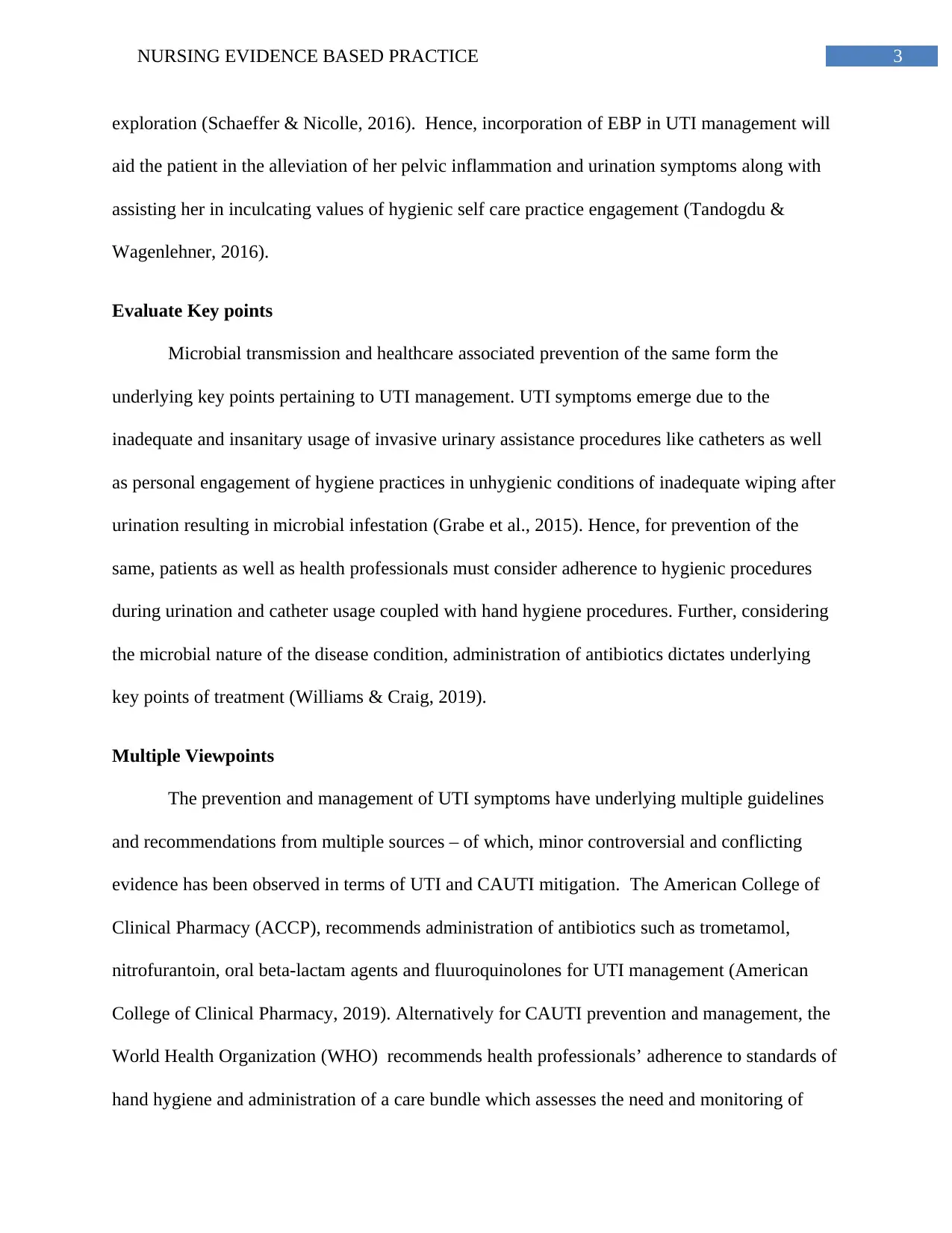
3NURSING EVIDENCE BASED PRACTICE
exploration (Schaeffer & Nicolle, 2016). Hence, incorporation of EBP in UTI management will
aid the patient in the alleviation of her pelvic inflammation and urination symptoms along with
assisting her in inculcating values of hygienic self care practice engagement (Tandogdu &
Wagenlehner, 2016).
Evaluate Key points
Microbial transmission and healthcare associated prevention of the same form the
underlying key points pertaining to UTI management. UTI symptoms emerge due to the
inadequate and insanitary usage of invasive urinary assistance procedures like catheters as well
as personal engagement of hygiene practices in unhygienic conditions of inadequate wiping after
urination resulting in microbial infestation (Grabe et al., 2015). Hence, for prevention of the
same, patients as well as health professionals must consider adherence to hygienic procedures
during urination and catheter usage coupled with hand hygiene procedures. Further, considering
the microbial nature of the disease condition, administration of antibiotics dictates underlying
key points of treatment (Williams & Craig, 2019).
Multiple Viewpoints
The prevention and management of UTI symptoms have underlying multiple guidelines
and recommendations from multiple sources – of which, minor controversial and conflicting
evidence has been observed in terms of UTI and CAUTI mitigation. The American College of
Clinical Pharmacy (ACCP), recommends administration of antibiotics such as trometamol,
nitrofurantoin, oral beta-lactam agents and fluuroquinolones for UTI management (American
College of Clinical Pharmacy, 2019). Alternatively for CAUTI prevention and management, the
World Health Organization (WHO) recommends health professionals’ adherence to standards of
hand hygiene and administration of a care bundle which assesses the need and monitoring of
exploration (Schaeffer & Nicolle, 2016). Hence, incorporation of EBP in UTI management will
aid the patient in the alleviation of her pelvic inflammation and urination symptoms along with
assisting her in inculcating values of hygienic self care practice engagement (Tandogdu &
Wagenlehner, 2016).
Evaluate Key points
Microbial transmission and healthcare associated prevention of the same form the
underlying key points pertaining to UTI management. UTI symptoms emerge due to the
inadequate and insanitary usage of invasive urinary assistance procedures like catheters as well
as personal engagement of hygiene practices in unhygienic conditions of inadequate wiping after
urination resulting in microbial infestation (Grabe et al., 2015). Hence, for prevention of the
same, patients as well as health professionals must consider adherence to hygienic procedures
during urination and catheter usage coupled with hand hygiene procedures. Further, considering
the microbial nature of the disease condition, administration of antibiotics dictates underlying
key points of treatment (Williams & Craig, 2019).
Multiple Viewpoints
The prevention and management of UTI symptoms have underlying multiple guidelines
and recommendations from multiple sources – of which, minor controversial and conflicting
evidence has been observed in terms of UTI and CAUTI mitigation. The American College of
Clinical Pharmacy (ACCP), recommends administration of antibiotics such as trometamol,
nitrofurantoin, oral beta-lactam agents and fluuroquinolones for UTI management (American
College of Clinical Pharmacy, 2019). Alternatively for CAUTI prevention and management, the
World Health Organization (WHO) recommends health professionals’ adherence to standards of
hand hygiene and administration of a care bundle which assesses the need and monitoring of
Secure Best Marks with AI Grader
Need help grading? Try our AI Grader for instant feedback on your assignments.

4NURSING EVIDENCE BASED PRACTICE
required insertion of catheters using aseptic procedures (World Health Organization, 2019). In
addition to the hygienic practices, the American Nurses Association, necessitates nursing
assessment of bladder emptying status in the patient for prevention of CAUTI. However, there
lies an absence of guidelines for home based or alternative strategies of UTI management which
is not associated with catheter usage, other than merely and online resource published by the
Centers for Disease Control and Prevention (Centers for Disease Control and Prevention, 2019).
Hence, conflicting evidence can be observed in terms of multiple recommendations of hand
hygiene, appropriate catheter insertion and administration of assessment care bundles underlying
CAUTI management - for which, consideration of multiple recommendations must be
disseminated to the care plan for the concerned patient for evidence based practice. However,
there lies an absence of alternative management of UTI - a key limitation underlying
administration of discharge education for self management of symptoms (Kronenberg et al.,
2017).
Soundness of Research
An extensive electronic literature search revealed availability of a wide range of studies
underlying recommendations of prevention of CAUTI symptoms, both in terms of scholarly,
peer reviewed articles as well as standardized guidelines by national and international bodies.
While wide variety of systematic review based articles based on EBP recommendations indicate
credible soundness in terms of availability of high quality research, a limited availability of
primary, quantitative based data on the same can be considered as a key limitation in terms of
research validity (Moher et al., 2015). This is due to the possibilities of publication bias in
review articles and beneficial absence of the same in primary based researches (Treweek et al.,
2018). Further, the limited availability of resources outlining home based or patient centered
required insertion of catheters using aseptic procedures (World Health Organization, 2019). In
addition to the hygienic practices, the American Nurses Association, necessitates nursing
assessment of bladder emptying status in the patient for prevention of CAUTI. However, there
lies an absence of guidelines for home based or alternative strategies of UTI management which
is not associated with catheter usage, other than merely and online resource published by the
Centers for Disease Control and Prevention (Centers for Disease Control and Prevention, 2019).
Hence, conflicting evidence can be observed in terms of multiple recommendations of hand
hygiene, appropriate catheter insertion and administration of assessment care bundles underlying
CAUTI management - for which, consideration of multiple recommendations must be
disseminated to the care plan for the concerned patient for evidence based practice. However,
there lies an absence of alternative management of UTI - a key limitation underlying
administration of discharge education for self management of symptoms (Kronenberg et al.,
2017).
Soundness of Research
An extensive electronic literature search revealed availability of a wide range of studies
underlying recommendations of prevention of CAUTI symptoms, both in terms of scholarly,
peer reviewed articles as well as standardized guidelines by national and international bodies.
While wide variety of systematic review based articles based on EBP recommendations indicate
credible soundness in terms of availability of high quality research, a limited availability of
primary, quantitative based data on the same can be considered as a key limitation in terms of
research validity (Moher et al., 2015). This is due to the possibilities of publication bias in
review articles and beneficial absence of the same in primary based researches (Treweek et al.,
2018). Further, the limited availability of resources outlining home based or patient centered
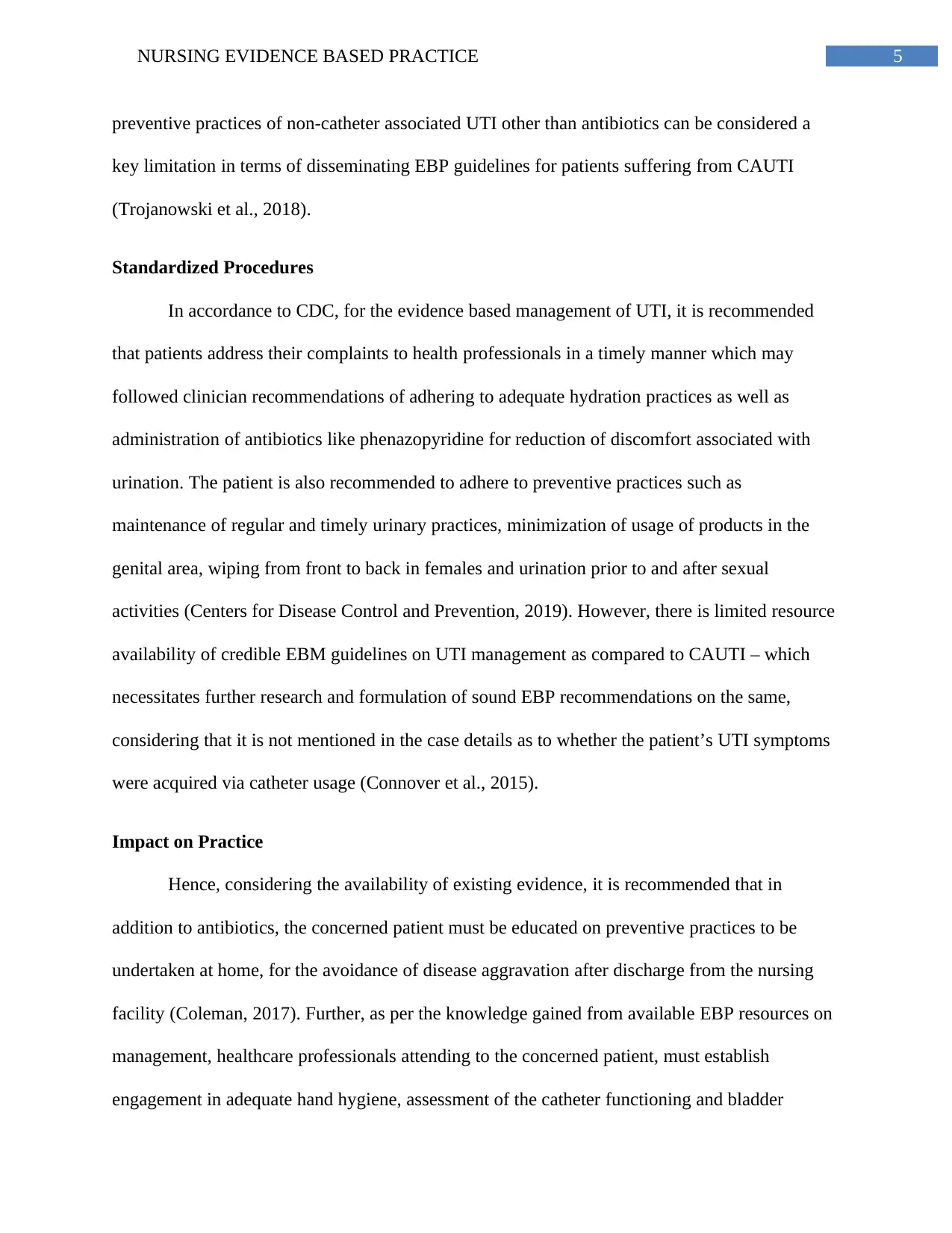
5NURSING EVIDENCE BASED PRACTICE
preventive practices of non-catheter associated UTI other than antibiotics can be considered a
key limitation in terms of disseminating EBP guidelines for patients suffering from CAUTI
(Trojanowski et al., 2018).
Standardized Procedures
In accordance to CDC, for the evidence based management of UTI, it is recommended
that patients address their complaints to health professionals in a timely manner which may
followed clinician recommendations of adhering to adequate hydration practices as well as
administration of antibiotics like phenazopyridine for reduction of discomfort associated with
urination. The patient is also recommended to adhere to preventive practices such as
maintenance of regular and timely urinary practices, minimization of usage of products in the
genital area, wiping from front to back in females and urination prior to and after sexual
activities (Centers for Disease Control and Prevention, 2019). However, there is limited resource
availability of credible EBM guidelines on UTI management as compared to CAUTI – which
necessitates further research and formulation of sound EBP recommendations on the same,
considering that it is not mentioned in the case details as to whether the patient’s UTI symptoms
were acquired via catheter usage (Connover et al., 2015).
Impact on Practice
Hence, considering the availability of existing evidence, it is recommended that in
addition to antibiotics, the concerned patient must be educated on preventive practices to be
undertaken at home, for the avoidance of disease aggravation after discharge from the nursing
facility (Coleman, 2017). Further, as per the knowledge gained from available EBP resources on
management, healthcare professionals attending to the concerned patient, must establish
engagement in adequate hand hygiene, assessment of the catheter functioning and bladder
preventive practices of non-catheter associated UTI other than antibiotics can be considered a
key limitation in terms of disseminating EBP guidelines for patients suffering from CAUTI
(Trojanowski et al., 2018).
Standardized Procedures
In accordance to CDC, for the evidence based management of UTI, it is recommended
that patients address their complaints to health professionals in a timely manner which may
followed clinician recommendations of adhering to adequate hydration practices as well as
administration of antibiotics like phenazopyridine for reduction of discomfort associated with
urination. The patient is also recommended to adhere to preventive practices such as
maintenance of regular and timely urinary practices, minimization of usage of products in the
genital area, wiping from front to back in females and urination prior to and after sexual
activities (Centers for Disease Control and Prevention, 2019). However, there is limited resource
availability of credible EBM guidelines on UTI management as compared to CAUTI – which
necessitates further research and formulation of sound EBP recommendations on the same,
considering that it is not mentioned in the case details as to whether the patient’s UTI symptoms
were acquired via catheter usage (Connover et al., 2015).
Impact on Practice
Hence, considering the availability of existing evidence, it is recommended that in
addition to antibiotics, the concerned patient must be educated on preventive practices to be
undertaken at home, for the avoidance of disease aggravation after discharge from the nursing
facility (Coleman, 2017). Further, as per the knowledge gained from available EBP resources on
management, healthcare professionals attending to the concerned patient, must establish
engagement in adequate hand hygiene, assessment of the catheter functioning and bladder
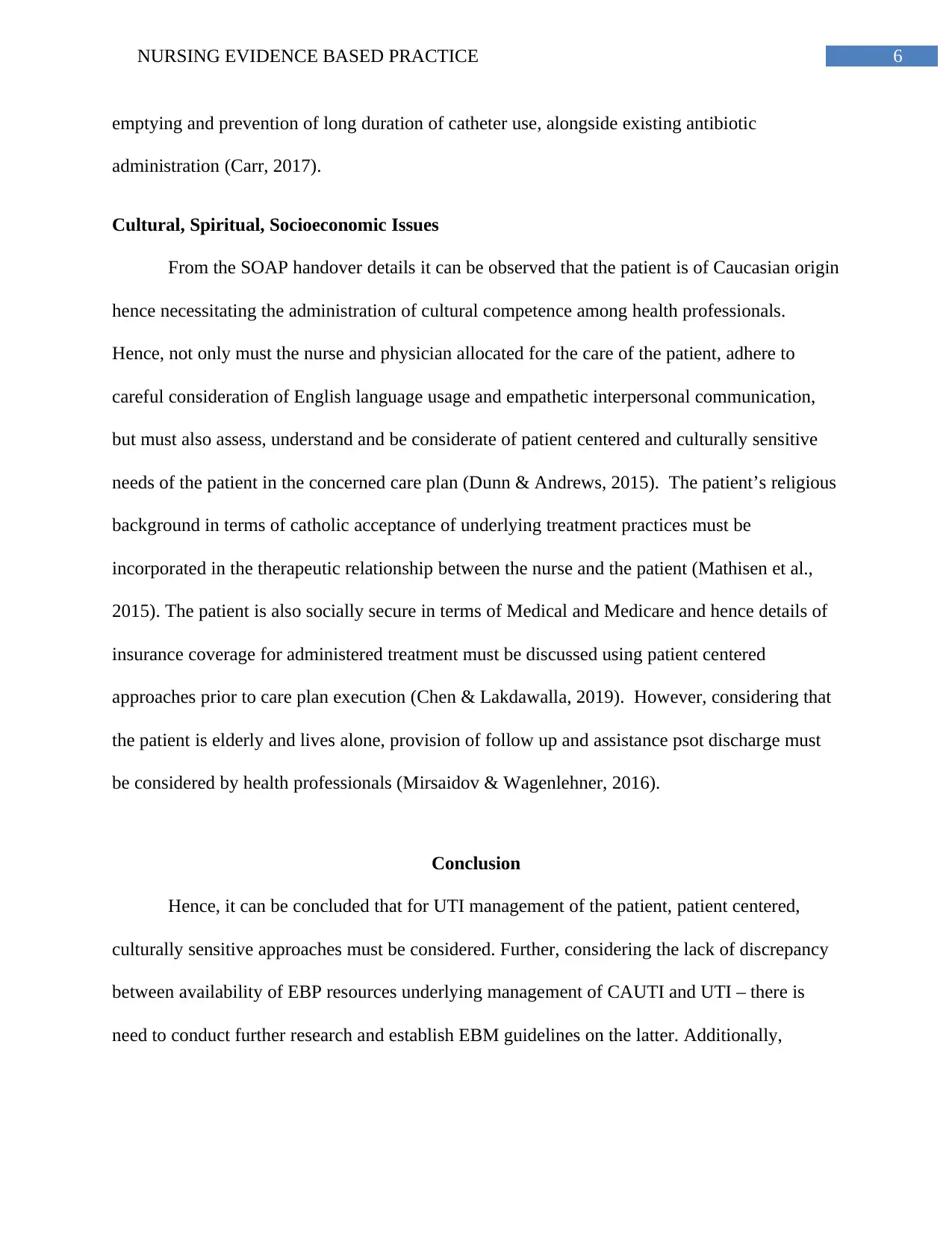
6NURSING EVIDENCE BASED PRACTICE
emptying and prevention of long duration of catheter use, alongside existing antibiotic
administration (Carr, 2017).
Cultural, Spiritual, Socioeconomic Issues
From the SOAP handover details it can be observed that the patient is of Caucasian origin
hence necessitating the administration of cultural competence among health professionals.
Hence, not only must the nurse and physician allocated for the care of the patient, adhere to
careful consideration of English language usage and empathetic interpersonal communication,
but must also assess, understand and be considerate of patient centered and culturally sensitive
needs of the patient in the concerned care plan (Dunn & Andrews, 2015). The patient’s religious
background in terms of catholic acceptance of underlying treatment practices must be
incorporated in the therapeutic relationship between the nurse and the patient (Mathisen et al.,
2015). The patient is also socially secure in terms of Medical and Medicare and hence details of
insurance coverage for administered treatment must be discussed using patient centered
approaches prior to care plan execution (Chen & Lakdawalla, 2019). However, considering that
the patient is elderly and lives alone, provision of follow up and assistance psot discharge must
be considered by health professionals (Mirsaidov & Wagenlehner, 2016).
Conclusion
Hence, it can be concluded that for UTI management of the patient, patient centered,
culturally sensitive approaches must be considered. Further, considering the lack of discrepancy
between availability of EBP resources underlying management of CAUTI and UTI – there is
need to conduct further research and establish EBM guidelines on the latter. Additionally,
emptying and prevention of long duration of catheter use, alongside existing antibiotic
administration (Carr, 2017).
Cultural, Spiritual, Socioeconomic Issues
From the SOAP handover details it can be observed that the patient is of Caucasian origin
hence necessitating the administration of cultural competence among health professionals.
Hence, not only must the nurse and physician allocated for the care of the patient, adhere to
careful consideration of English language usage and empathetic interpersonal communication,
but must also assess, understand and be considerate of patient centered and culturally sensitive
needs of the patient in the concerned care plan (Dunn & Andrews, 2015). The patient’s religious
background in terms of catholic acceptance of underlying treatment practices must be
incorporated in the therapeutic relationship between the nurse and the patient (Mathisen et al.,
2015). The patient is also socially secure in terms of Medical and Medicare and hence details of
insurance coverage for administered treatment must be discussed using patient centered
approaches prior to care plan execution (Chen & Lakdawalla, 2019). However, considering that
the patient is elderly and lives alone, provision of follow up and assistance psot discharge must
be considered by health professionals (Mirsaidov & Wagenlehner, 2016).
Conclusion
Hence, it can be concluded that for UTI management of the patient, patient centered,
culturally sensitive approaches must be considered. Further, considering the lack of discrepancy
between availability of EBP resources underlying management of CAUTI and UTI – there is
need to conduct further research and establish EBM guidelines on the latter. Additionally,
Paraphrase This Document
Need a fresh take? Get an instant paraphrase of this document with our AI Paraphraser

7NURSING EVIDENCE BASED PRACTICE
considering the possibilities of bias associated with review based sources, conductance of
primary research on UTI and CAUTI management is of utmost importance.
considering the possibilities of bias associated with review based sources, conductance of
primary research on UTI and CAUTI management is of utmost importance.

8NURSING EVIDENCE BASED PRACTICE
References
American College of Clinical Pharmacy. (2019). Urinary Tract Infections. Retrieved from
https://www.accp.com/docs/bookstore/psap/p2018b1_sample.pdf.
American College of Clinical Pharmacy. (2019). Urinary Tract Infections. Retrieved from
https://www.accp.com/docs/bookstore/psap/p2018b1_sample.pdf.
Carr, A. N. (2017). CAUTI Prevention: Streaming Quality Care in a Progressive Care
Unit. MedSurg Nursing, 26(5).
Centers for Disease Control and Prevention. (2019). Urinary Tract Infection | Community |
Antibiotic Use | CDC. Retrieved from
https://www.cdc.gov/antibiotic-use/community/for-patients/common-illnesses/uti.html.
Chen, A., & Lakdawalla, D. N. (2019). Healing the poor: The influence of patient socioeconomic
status on physician supply responses. Journal of health economics, 64, 43-54.
Coleman, T. (2017). Assessing the need for urinary catheters daily and reducing CAUTI rates
nation-wide.
Conover, M. S., Flores-Mireles, A. L., Hibbing, M. E., Dodson, K., & Hultgren, S. J. (2015).
Establishment and characterization of UTI and CAUTI in a mouse model. JoVE (Journal
of Visualized Experiments), (100), e52892.
Dunn, D. S., & Andrews, E. E. (2015). Person-first and identity-first language: Developing
psychologists’ cultural competence using disability language. American
Psychologist, 70(3), 255.
References
American College of Clinical Pharmacy. (2019). Urinary Tract Infections. Retrieved from
https://www.accp.com/docs/bookstore/psap/p2018b1_sample.pdf.
American College of Clinical Pharmacy. (2019). Urinary Tract Infections. Retrieved from
https://www.accp.com/docs/bookstore/psap/p2018b1_sample.pdf.
Carr, A. N. (2017). CAUTI Prevention: Streaming Quality Care in a Progressive Care
Unit. MedSurg Nursing, 26(5).
Centers for Disease Control and Prevention. (2019). Urinary Tract Infection | Community |
Antibiotic Use | CDC. Retrieved from
https://www.cdc.gov/antibiotic-use/community/for-patients/common-illnesses/uti.html.
Chen, A., & Lakdawalla, D. N. (2019). Healing the poor: The influence of patient socioeconomic
status on physician supply responses. Journal of health economics, 64, 43-54.
Coleman, T. (2017). Assessing the need for urinary catheters daily and reducing CAUTI rates
nation-wide.
Conover, M. S., Flores-Mireles, A. L., Hibbing, M. E., Dodson, K., & Hultgren, S. J. (2015).
Establishment and characterization of UTI and CAUTI in a mouse model. JoVE (Journal
of Visualized Experiments), (100), e52892.
Dunn, D. S., & Andrews, E. E. (2015). Person-first and identity-first language: Developing
psychologists’ cultural competence using disability language. American
Psychologist, 70(3), 255.
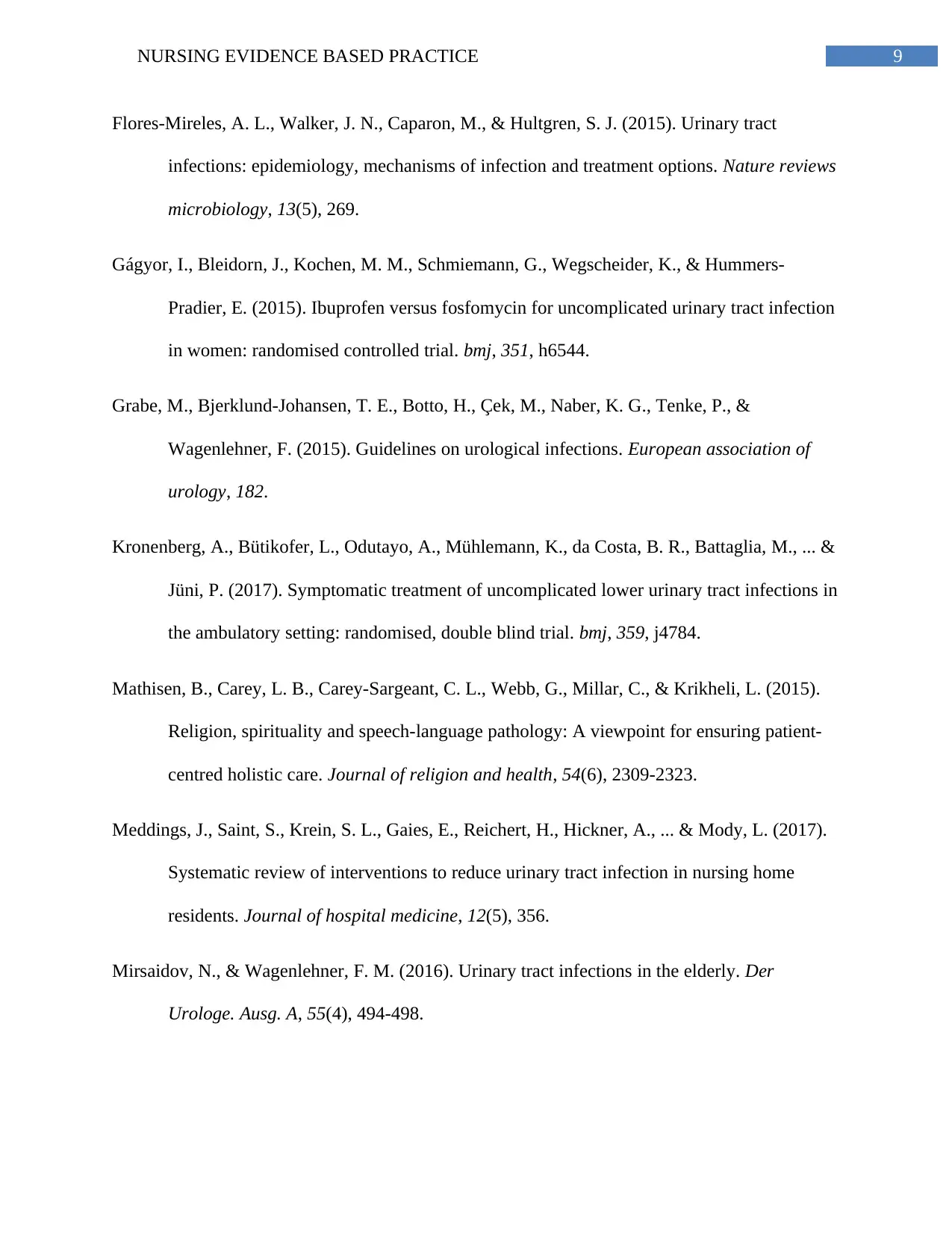
9NURSING EVIDENCE BASED PRACTICE
Flores-Mireles, A. L., Walker, J. N., Caparon, M., & Hultgren, S. J. (2015). Urinary tract
infections: epidemiology, mechanisms of infection and treatment options. Nature reviews
microbiology, 13(5), 269.
Gágyor, I., Bleidorn, J., Kochen, M. M., Schmiemann, G., Wegscheider, K., & Hummers-
Pradier, E. (2015). Ibuprofen versus fosfomycin for uncomplicated urinary tract infection
in women: randomised controlled trial. bmj, 351, h6544.
Grabe, M., Bjerklund-Johansen, T. E., Botto, H., Çek, M., Naber, K. G., Tenke, P., &
Wagenlehner, F. (2015). Guidelines on urological infections. European association of
urology, 182.
Kronenberg, A., Bütikofer, L., Odutayo, A., Mühlemann, K., da Costa, B. R., Battaglia, M., ... &
Jüni, P. (2017). Symptomatic treatment of uncomplicated lower urinary tract infections in
the ambulatory setting: randomised, double blind trial. bmj, 359, j4784.
Mathisen, B., Carey, L. B., Carey-Sargeant, C. L., Webb, G., Millar, C., & Krikheli, L. (2015).
Religion, spirituality and speech-language pathology: A viewpoint for ensuring patient-
centred holistic care. Journal of religion and health, 54(6), 2309-2323.
Meddings, J., Saint, S., Krein, S. L., Gaies, E., Reichert, H., Hickner, A., ... & Mody, L. (2017).
Systematic review of interventions to reduce urinary tract infection in nursing home
residents. Journal of hospital medicine, 12(5), 356.
Mirsaidov, N., & Wagenlehner, F. M. (2016). Urinary tract infections in the elderly. Der
Urologe. Ausg. A, 55(4), 494-498.
Flores-Mireles, A. L., Walker, J. N., Caparon, M., & Hultgren, S. J. (2015). Urinary tract
infections: epidemiology, mechanisms of infection and treatment options. Nature reviews
microbiology, 13(5), 269.
Gágyor, I., Bleidorn, J., Kochen, M. M., Schmiemann, G., Wegscheider, K., & Hummers-
Pradier, E. (2015). Ibuprofen versus fosfomycin for uncomplicated urinary tract infection
in women: randomised controlled trial. bmj, 351, h6544.
Grabe, M., Bjerklund-Johansen, T. E., Botto, H., Çek, M., Naber, K. G., Tenke, P., &
Wagenlehner, F. (2015). Guidelines on urological infections. European association of
urology, 182.
Kronenberg, A., Bütikofer, L., Odutayo, A., Mühlemann, K., da Costa, B. R., Battaglia, M., ... &
Jüni, P. (2017). Symptomatic treatment of uncomplicated lower urinary tract infections in
the ambulatory setting: randomised, double blind trial. bmj, 359, j4784.
Mathisen, B., Carey, L. B., Carey-Sargeant, C. L., Webb, G., Millar, C., & Krikheli, L. (2015).
Religion, spirituality and speech-language pathology: A viewpoint for ensuring patient-
centred holistic care. Journal of religion and health, 54(6), 2309-2323.
Meddings, J., Saint, S., Krein, S. L., Gaies, E., Reichert, H., Hickner, A., ... & Mody, L. (2017).
Systematic review of interventions to reduce urinary tract infection in nursing home
residents. Journal of hospital medicine, 12(5), 356.
Mirsaidov, N., & Wagenlehner, F. M. (2016). Urinary tract infections in the elderly. Der
Urologe. Ausg. A, 55(4), 494-498.
Secure Best Marks with AI Grader
Need help grading? Try our AI Grader for instant feedback on your assignments.
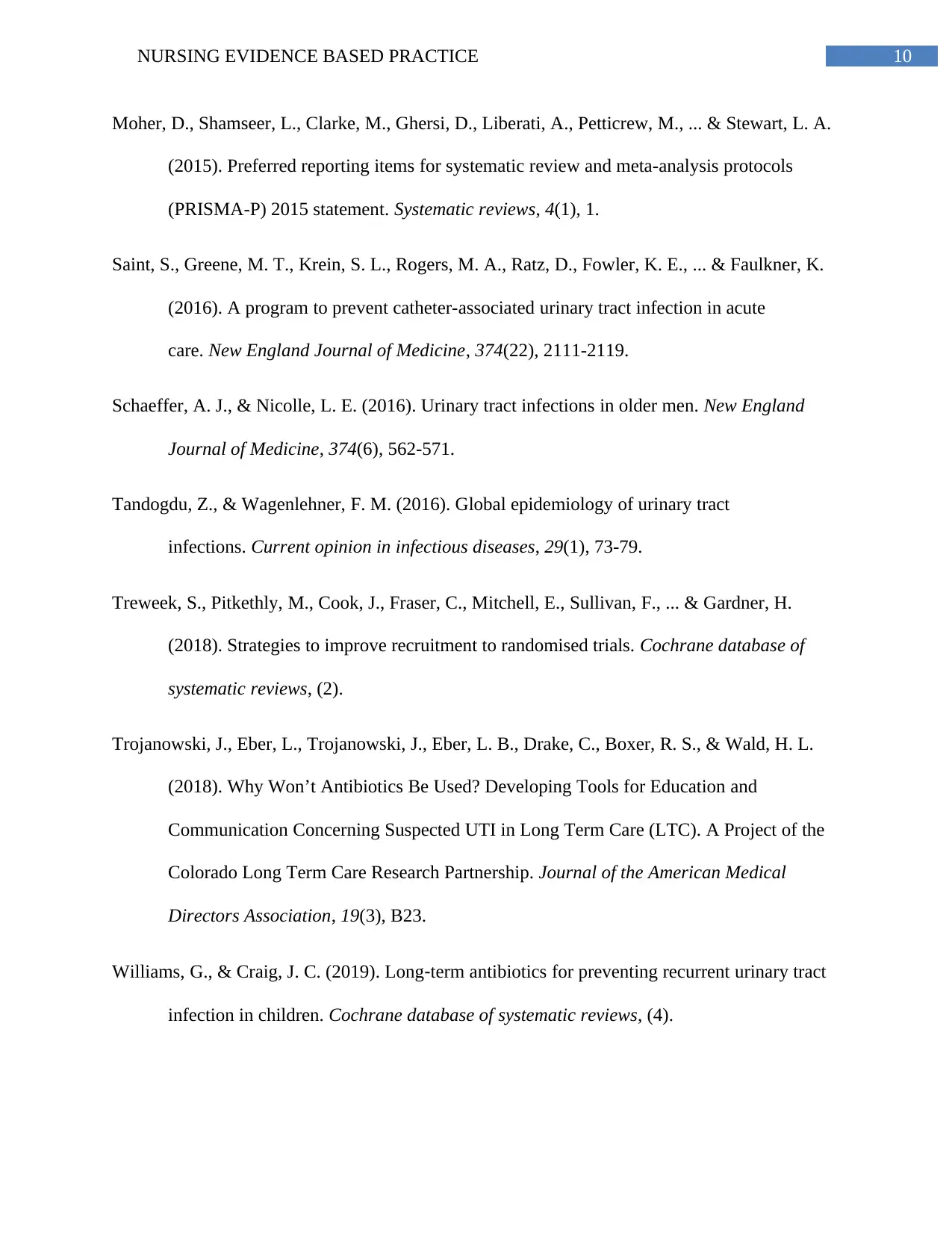
10NURSING EVIDENCE BASED PRACTICE
Moher, D., Shamseer, L., Clarke, M., Ghersi, D., Liberati, A., Petticrew, M., ... & Stewart, L. A.
(2015). Preferred reporting items for systematic review and meta-analysis protocols
(PRISMA-P) 2015 statement. Systematic reviews, 4(1), 1.
Saint, S., Greene, M. T., Krein, S. L., Rogers, M. A., Ratz, D., Fowler, K. E., ... & Faulkner, K.
(2016). A program to prevent catheter-associated urinary tract infection in acute
care. New England Journal of Medicine, 374(22), 2111-2119.
Schaeffer, A. J., & Nicolle, L. E. (2016). Urinary tract infections in older men. New England
Journal of Medicine, 374(6), 562-571.
Tandogdu, Z., & Wagenlehner, F. M. (2016). Global epidemiology of urinary tract
infections. Current opinion in infectious diseases, 29(1), 73-79.
Treweek, S., Pitkethly, M., Cook, J., Fraser, C., Mitchell, E., Sullivan, F., ... & Gardner, H.
(2018). Strategies to improve recruitment to randomised trials. Cochrane database of
systematic reviews, (2).
Trojanowski, J., Eber, L., Trojanowski, J., Eber, L. B., Drake, C., Boxer, R. S., & Wald, H. L.
(2018). Why Won’t Antibiotics Be Used? Developing Tools for Education and
Communication Concerning Suspected UTI in Long Term Care (LTC). A Project of the
Colorado Long Term Care Research Partnership. Journal of the American Medical
Directors Association, 19(3), B23.
Williams, G., & Craig, J. C. (2019). Long‐term antibiotics for preventing recurrent urinary tract
infection in children. Cochrane database of systematic reviews, (4).
Moher, D., Shamseer, L., Clarke, M., Ghersi, D., Liberati, A., Petticrew, M., ... & Stewart, L. A.
(2015). Preferred reporting items for systematic review and meta-analysis protocols
(PRISMA-P) 2015 statement. Systematic reviews, 4(1), 1.
Saint, S., Greene, M. T., Krein, S. L., Rogers, M. A., Ratz, D., Fowler, K. E., ... & Faulkner, K.
(2016). A program to prevent catheter-associated urinary tract infection in acute
care. New England Journal of Medicine, 374(22), 2111-2119.
Schaeffer, A. J., & Nicolle, L. E. (2016). Urinary tract infections in older men. New England
Journal of Medicine, 374(6), 562-571.
Tandogdu, Z., & Wagenlehner, F. M. (2016). Global epidemiology of urinary tract
infections. Current opinion in infectious diseases, 29(1), 73-79.
Treweek, S., Pitkethly, M., Cook, J., Fraser, C., Mitchell, E., Sullivan, F., ... & Gardner, H.
(2018). Strategies to improve recruitment to randomised trials. Cochrane database of
systematic reviews, (2).
Trojanowski, J., Eber, L., Trojanowski, J., Eber, L. B., Drake, C., Boxer, R. S., & Wald, H. L.
(2018). Why Won’t Antibiotics Be Used? Developing Tools for Education and
Communication Concerning Suspected UTI in Long Term Care (LTC). A Project of the
Colorado Long Term Care Research Partnership. Journal of the American Medical
Directors Association, 19(3), B23.
Williams, G., & Craig, J. C. (2019). Long‐term antibiotics for preventing recurrent urinary tract
infection in children. Cochrane database of systematic reviews, (4).
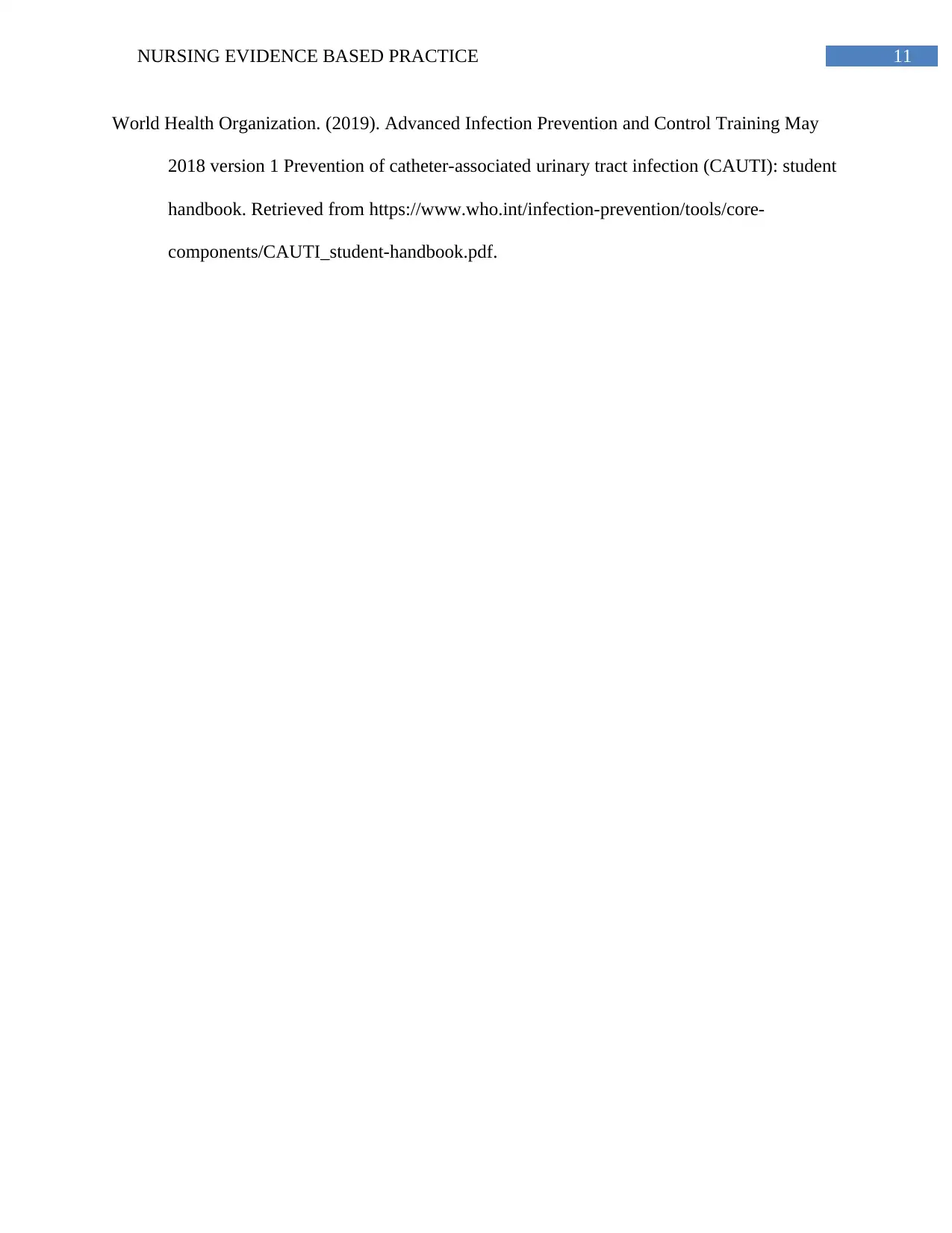
11NURSING EVIDENCE BASED PRACTICE
World Health Organization. (2019). Advanced Infection Prevention and Control Training May
2018 version 1 Prevention of catheter-associated urinary tract infection (CAUTI): student
handbook. Retrieved from https://www.who.int/infection-prevention/tools/core-
components/CAUTI_student-handbook.pdf.
World Health Organization. (2019). Advanced Infection Prevention and Control Training May
2018 version 1 Prevention of catheter-associated urinary tract infection (CAUTI): student
handbook. Retrieved from https://www.who.int/infection-prevention/tools/core-
components/CAUTI_student-handbook.pdf.
1 out of 12
Related Documents
Your All-in-One AI-Powered Toolkit for Academic Success.
+13062052269
info@desklib.com
Available 24*7 on WhatsApp / Email
![[object Object]](/_next/static/media/star-bottom.7253800d.svg)
Unlock your academic potential
© 2024 | Zucol Services PVT LTD | All rights reserved.




